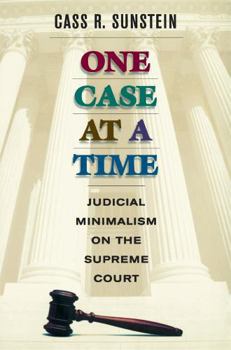One Case at a Time: Judicial Minimalism on the Supreme Court
Select Format
Select Condition 
Book Overview
Abortion, affirmative action, the "right to die," pornography and free speech, homosexuality and sex discrimination: as eagerly as the Supreme Court's rulings on these hot issues are awaited and as intently as they're studied, they never seem to settle anything once and for all. But something is settled in the process--in the incremental approach--as Cass Sunstein shows us in this instructive book.
Format:Paperback
Language:English
ISBN:0674005791
ISBN13:9780674005792
Release Date:April 2001
Publisher:Harvard University Press
Length:304 Pages
Weight:1.00 lbs.
Dimensions:0.8" x 6.2" x 9.3"
Customer Reviews
3 ratings
An intriguing examination of how the Supreme Court operates
Published by Thriftbooks.com User , 19 years ago
It is a common piece of political rhetoric that courts run this country; you see this most commonly from the right. Sunstein presents an alternative that actually examines how the Supreme Court operates across broad categories. Sunstein develops the theory of minimalism. Under this theory, Sunstein argues that courts should proceed cautiously in deciding cases that involve complex and difficult areas of constitutional law. Courts have institutional limitations that make it difficult for them to provide hard rules that will decide every case in the future. One recurring example is Roe v. Wade where the Court attempted to lay out a broad rule. The experience with this broad rule demonstrated that the Court's attempt was a bad idea in that it had insufficient knowledge to adequately develop rules to deal with all contingencies. That is why the Court itself eventually abandoned Roe's broad rule in Casey. While Sunstein warns against broad and far-reaching rules, he does not say that all such rules are invalid. Instead he argues that such rules should be limited for those few cases and areas that a consensus exists and the risk of error is minimal; an example of which is Brown where the Court had a series of decisions lending support to its ultimate resolution of segregation. After describing minimalism, Sunstein analyzes the Court's recent decisions regarding assisted suicide, affirmative action, sex and sexual orientation, and the first amendment dealing with cable and internet issues. In each of these areas the Court has proceeded in a minimalist fashion, which Sunstein describes and defends. Contrary to another reviewer's assertion, Sunstein does not use his theory to justify "liberal" values while attacking "conservative" justices. In fact he notes that Rehnquist, hardly a liberal, often operates in a minimalist fashion. His critique of Scalia has nothing to do with conservatism and is instead aimed at the fact that Scalia is the foremost maximalist. He argues for broad rules meant to provide certainty. Sunstein analyzes Scalia's constitutional theory solely in terms of the limitation of maximalism, and does not in any way attack Scalia for his conservatism. The best thing about minimalism is that it seeks to allow democratic deliberation to assist in constitutional development. In deciding cases in a minimalist fashion, the Court allows democratic assemblies to work out new approaches to difficult areas. In fact, one benefit of federalism has long been understood to be promoting experimentation. Democratic assemblies have the fact gathering ability and deliberative processes that can best develop rules to deal with future problems.
Response to "Sad....Brilliant Mind."
Published by Thriftbooks.com User , 24 years ago
Review titled "Sad...Brilliant Mind" is misguided and his criticism is misplaced. His erudiction is impressive (lots of foreign, erudite words to be sure) but his analysis confuses several critical positions. Read "One Case at a Time" and you will gain a better idea of how fundamentally flawed our democratic process actually is and the role of the judiciary as a buffer against a tyranny by the majority. To understand the Supreme Court since 1954, one must see the historical circumstances of that era.
Succinct analysis of how the Supreme Court decides cases
Published by Thriftbooks.com User , 25 years ago
This is an essential text for anyone interested in legal reasoning and legal process. I would go so far as to say it will be on the same bookshelf as Oliver Wendall Holmes and other great jurisprudential commentators. It should also be required reading for every law student, and their professors as well. Sunstein, a law professor at the University of Chicago Law School, gives clear, diagramatic analyses of the principles upon which the Supreme Court (and other courts and judges) base their decisions.That having been said, this is neither a quick nor superficial read. It assumes the reader's familiarity with legal process and decisionmaking, and of the salient issues before the courts. Nevertheless, the overall result is deeply satisfying as a method of analysis. Anyone interested in law should buy the book, and read it, not once but several times.






